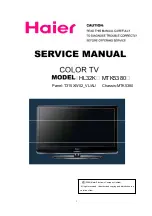
2-Tuner PIP 206-3481
P A G E 3 6
PIP Overview
Variable
Audio Output
L-Audio
R-Audio
S-Video Video
Antenna / Cable
R
L
PIP = Picture-In-Picture
Think of PIP as a mini TV screen superimposed onto your main TV screen
PIP Inset Picture
Main Picture
YOUR PICTURE-IN-PICTURE FEATURE
The Picture-In-Picture (PIP) function allows you to put a smaller
picture, called the “PIP inset,” on the bigger screen, or the
“main” picture.
Normally you would need some other piece of equipment, like a
VCR, to act as a tuner to receive and display a second channel at
the same time. Your Entertainment Machine eliminates that need
by giving you two tuners on one TV. PIP is always available, no
matter what equipment you have.
Don’t want to miss any of the big game, but hate commercials?
Just put the game in the PIP inset, and surf your favorite chan-
nels on the main picture.
WORKING WITH PIP
Just like your Entertainment Machine’s main screen, PIP will need
a source to take its image from. Set the main screen source to
Antenna/Cable, then set the PIP source to Antenna/Cable, as an
example. This can be adjusted under the Source menu (see page
35).
PIP can be used in any picture mode: Put Antenna/Cable in the
inset while you watch a video tape. Attached to the Video input
jacks, have a DVD disk playing in the PIP inset, while you watch
the Antenna/Cable source’s program on the main screen.
POSSIBLE REASONS FOR ADJUSTING PIP SOURCE
1. You want to watch a videotape, but keep scanning for another
movie or game. Set the PIP source to Video and you can watch
the VCR and TV, swapping between the two.
2. You want to watch your favorite live program on the
Antenna/Cable source on the main picture and when a commer-
cial break appears, swap to the PIP inset, which has a video-
tape in the VCR ready to play, or (for the PIP source) choose a
different channel on Antenna/Cable.
Содержание B27B40Z
Страница 50: ...206 3375 P A G E 5 0 Notes ...
















































